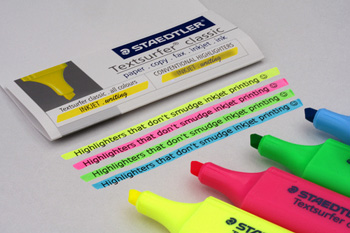Study the chart below. The first column lists tools that will help you annotate. The second column lists methods for marking the text. The last column makes suggestions for what to mark. Your purpose for reading will determine which techniques you choose for marking the text and what information you choose to mark.
| Tools | Techniques | Information to Mark |
|---|---|---|
|
|
|
Feel free to create your own system, but be consistent. For example, always highlight main ideas in one color and supporting details in another. Consistency will be helpful when you review the text. The goal is to leave a trail that will make it easier to find information on a second reading.
Of course, annotation requires practice. The techniques of highlighting and circling unfamiliar words are the key to forming good annotation habits.
Highlighting

Source: Highlighters that don't smudge inkjet printing, Leo Reynolds, Flickr
Your goal is to highlight the text sparingly. If you highlight or underline entire sentences, the essential information you need to locate when you reread won’t stand out.
Try to develop a telegraphic approach to highlighting. In the early days of Texas, when people transmitted information via telegraph, they were charged by the word. To save money, people included only the most essential information in their messages. Likewise, you should restrict your highlighting to as few words as possible in each sentence.
Circling and Defining Unfamiliar Words

Source: carrerasmarch12-7, St. Bernard Project, Flickr
This is a very important step when you are reading challenging material in your English or other classes. Circle the words while you are reading. Then use a dictionary or thesaurus to write a brief definition or synonym in the margin near the circled word.
Take a look at what I’ve highlighted below while reading Carl Sagan’s ideas about a “cosmic calendar.” This text originally appeared in The Dragons of Eden, Sagan’s Pulitzer Prize-winning book about the evolution of human intelligence. Note the unfamiliar words I have circled.
The world is very old, and human beings are very young. Significant events in our personal lives are measured in years or less; our lifetimes in decades; our family genealogies in centuries; and all of recorded history in millennia. But we have been preceded by an awesome vista of time, extending for prodigious periods into the past, about which we know little—both because there are no written records and because we have real difficulty in grasping the immensity of the intervals involved.
Yet we are able to date events in the remote past. Geological stratification and radioactive dating provide information on archaeological, paleontological and geological events; and astrophysical theory provides data on the ages of planetary surfaces, stars, and the Milky Way Galaxy, as well as an estimate of the time that has elapsed since that extraordinary event called the Big Bang—an explosion that involved all of the matter and energy in the present universe. The Big Bang may be the beginning of the universe, or it may be a discontinuity in which information about the earlier history of the universe was destroyed. But it is certainly the earliest event about which we have any record.
Notice that I highlighted individual words or phrases but not entire sentences. I skipped conjunctions (and, or, but) and prepositions (in, on, of, etc.). I concentrated only on the words that were essential to Sagan’s meaning. If another person read just the highlighted words, he would not grasp the full meaning of the passage. When I read them, however, those key words will remind me of the full meaning. I also circled four words that were unfamiliar so I could look up their definitions. When I look up these words, I will draw an arrow from each circled word to each brief definition or synonym in the margin.